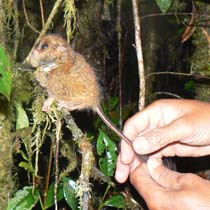
November 24, 2008
Due to all that’s been going on, I am still playing catchup with the recent “discovery news,” and a big one happened last week that I don’t want to miss sharing.
It is always good to hear about the rediscovery of a primate, and one caught and killed after nearly 80 years is news. Having finally seen the species alive after 87 years is indeed bigger news.
Scientists have observed a living pygmy tarsier (Tarsius pumilus), one of the planet’s smallest and rarest primates, for the first time since 1921. The primate was rediscovered on a misty mountaintop, on the Indonesian island of Sulawesi.
In 2000, Indonesian scientists who were trapping rats in the Sulawesi highlands accidentally trapped and killed a pygmy tarsier, spurring excitement to study the long lost primates again. Until that time, everyone really didn’t believe that they existed because people had been going out looking for them for decades and nobody had seen them or heard them.
Tarsiers are unusual primates — the mammalian group that includes lemurs, monkeys, apes and people. The handful of tarsier species live on various Asian islands. They are nocturnal insectivores and are unusual among primates in that they have claws rather than finger nails. The pygmy tarsier is also known as the mountain tarsier or the lesser spectral tarsier.
As their name indicates, pygmy tarsiers are small — weighing about 2 ounces (50 grammes). They have large eyes and large ears, and they have been described as looking a bit like one of the creatures in the 1984 Hollywood movie “Gremlins.”
The group observed the first live pygmy tarsier in August 2008 at an elevation of about 6,900 feet. Over a two-month period, the scientists used nets to trap three furry, mouse-sized pygmy tarsiers — two males and one female — on Mt. Rore Katimbo in Lore Lindu National Park in central Sulawesi, the researchers said last Tuesday.

Sharon Gursky-Doyen/Texas A&M University/Handout photo.
They spotted a fourth one that got away. (It’s always that third or fourth one, it seems, that gets away!)
The tarsiers, which some scientists believed were extinct, may not have been overly thrilled to be found. One of them chomped Sharon Gursky-Doyen, a Texas A&M University professor of anthropology who took part in the expedition.
“I’m the only person in the world to ever be bitten by a pygmy tarsier,” Gursky-Doyen said in a telephone interview.
“My assistant was trying to hold him still while I was attaching a radio collar (to track its future movements) around its neck. It’s very hard to hold them because they can turn their heads around 180 degrees. As I’m trying to close the radio collar, he turned his head and nipped my finger. And I yanked it and I was bleeding.”
About Loren Coleman
Loren Coleman is one of the world’s leading cryptozoologists, some say “the” leading living cryptozoologist. Certainly, he is acknowledged as the current living American researcher and writer who has most popularized cryptozoology in the late 20th and early 21st centuries.
Starting his fieldwork and investigations in 1960, after traveling and trekking extensively in pursuit of cryptozoological mysteries, Coleman began writing to share his experiences in 1969. An honorary member of Ivan T. Sanderson’s Society for the Investigation of the Unexplained in the 1970s, Coleman has been bestowed with similar honorary memberships of the North Idaho College Cryptozoology Club in 1983, and in subsequent years, that of the British Columbia Scientific Cryptozoology Club, CryptoSafari International, and other international organizations. He was also a Life Member and Benefactor of the International Society of Cryptozoology (now-defunct).
Loren Coleman’s daily blog, as a member of the Cryptomundo Team, served as an ongoing avenue of communication for the ever-growing body of cryptozoo news from 2005 through 2013. He returned as an infrequent contributor beginning Halloween week of 2015.
Coleman is the founder in 2003, and current director of the International Cryptozoology Museum in Portland, Maine.
Filed under Cryptotourism, CryptoZoo News, Cryptozoologists, Cryptozoology, New Species